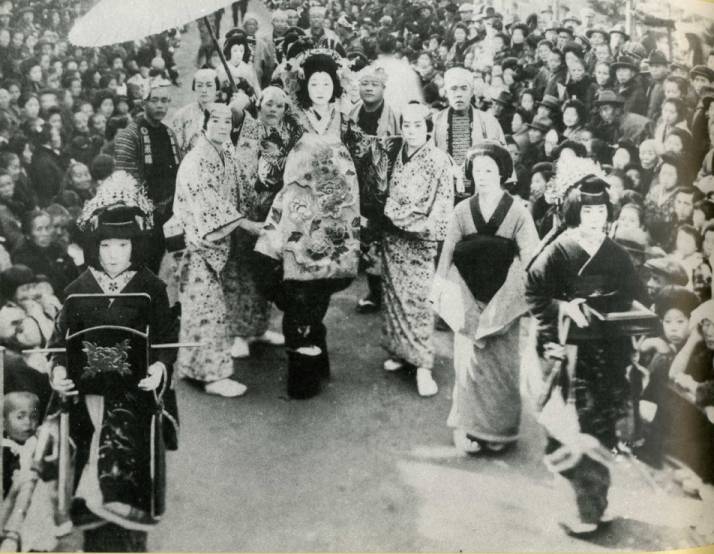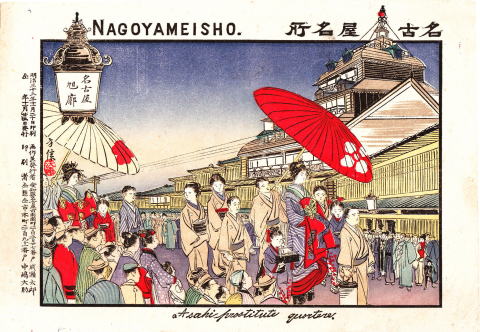| "åå@(Omon)/lit.large gate" was the gate to the Red-Light district. |
Omon street |
Structures in the Old-Time Nakamura Red-Light District
(Nakamura Yukaku)
The red-light district was moved to Nakamura from Osu (Asahiro Red-Light District) in 1923.
| "åå@(Omon)/lit.large gate" was the gate to the Red-Light district. |
Omon street |
Meiji Government tried to abolish the system of prostitution in 1872, but
In 1956 antiprostitution laws were enacted and
in 1958 red-light area was dead.
| Choju-an (·õÁ) built in 1923 (Now private) ....Designated Nagoya City's Important structure | |
There are many interesting buildings including three Nagoya City's Important
Structures Constituting Historic Townscape,
which built in 1924 or 1925, in the old Nakamura red-light district.
They are in the very limmited area: Omon-cho, Nigiwai-cho, Hagoromo-cho,
Kotobuki-cho and Hiyoshi-cho.
This area was designed and built in imitation of Yoshiwara in Edo (present
Tokyo).
<history>
Tokugawa Ieyasu (shogun) allowed to make red-light-like district conditionaly
for samurai, carpenters, marchants, etc.
who concerned the construction of Nagoya Castle in 1610.
It existed at present 3-chome, Nishiki, Naka-ku (near Sakae) and was called
"Tobita-cho Kuruwa".
(That place was out of main area of Nagoya and it had been such place before
it was allowed)
Then, after finish the castle, it was soon closed by Tokugawa Yoshinao,
the first lord of Owari Clan,
who hate corruption of public morals.
| Matsuoka ¼ª South entrance | Matsuoka ¼ª North entrance |
| (Now the structure is used as a day-care center for aged people) ....designated Nagoya City's Important structure | |
The 7th lord, Tokugawa Muneharu, brought back the red-light district which
calld "Nishikoji-kuruwa"
at present Sanno-bashi (Naka Ward) in March, 1732, and two more districts,
as required by the mandate of the Shogun, Tokugawa Yoshimune, who put emphasis
modesty and frugality.
However, they got prohibition of business again in 1753. Buildings were
destroyed but prostitutes kept their business privatery there.
| Inamoto î{@(Now Japanese Restaurant) ....Designated Nagoya City's Important structure | |
After long time, in 1858, the red-light business revived.
An owner of the inn, Sasaya Shobei, asked the government to gather of
actores or performers at the north of Osu-Kannon.
This was the origin of "Asahi Yukaku®Vs/Asahi red-light district".
(*Later, Asahi Red-light district was forced into relocation from Osu to
Nakamura.)
1919 (Taisho 8), the governor of Aichi Pref. decided to relace the Asahi
Red-light district to Nakamura.
At that time, the relaced area was in the center of rice field, so they
have to level the ground
and built a new town including Omon-cho, Nigiwai-cho, Hagoromo-cho, Kotobuki-cho
and Hiyoshi-cho.
| <Old sightseeing leaflet of Nagoya> I can't believe it ! Before the World War II, it seemed that Nakamura Red-light district was one of the tourist attractions in Nagoya. |
 |
||
|
In April 1923, Nakamura Red-Light District was open.
As its peak, there were 138 structures and 2000 workers.
(After the Great Kanto Earthquake struck on September 1st in 1923, many
performers (victims) moved to
Nakamura to earn their bread and butter.)
Then at the time of outbreak of the World War II, 100 houses were closed
to business.
The Antiprostitution Law went into effect in 1958 and the business in this
area has changed.
|
|
From Nagoya, go straight approx. 20 min. on foot. |
Similar allotment of land is also remaining around Otobashi -Koen
******
Nakamura Red-Light District was surrounded by a moat.
I guess that had been filled with tears of poor women.
******
Access
Walk straight approx. 15 min from Nagoya Station Taiko-dori side.
![]()
Asahi-ro
(Red-light district in Osu)
 |
|
| Nagoya guide leaflet of Asahi Red-light District published in 1895 |
There is a grave of prostitutes, who worked and died in the Asahiro red-light district, in Nittai-ji cemetery. |